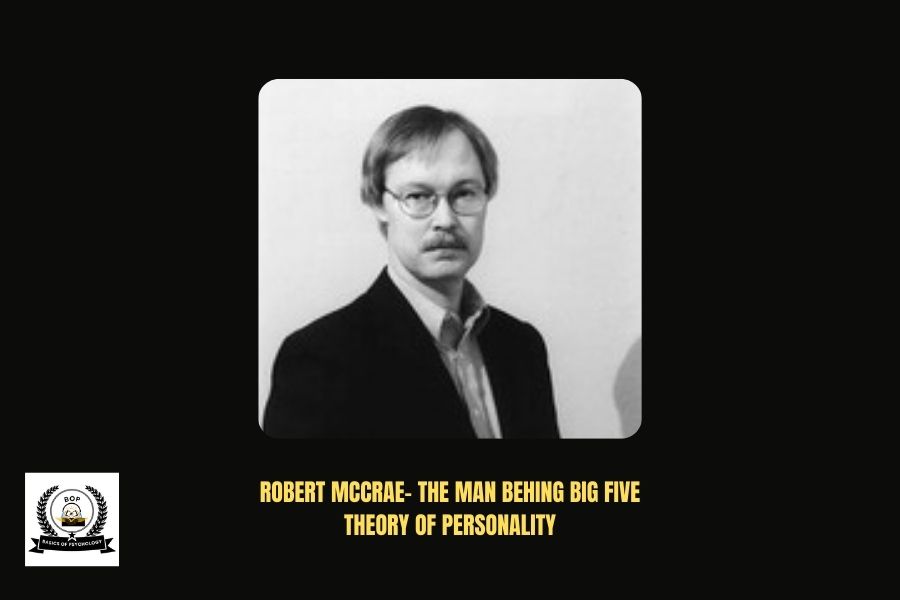Are you ready to have some wander in the amazing realm of psychology and find out the great achievements of one of its most prominent scientists, ‘Robert McCrae’? In such an exciting trip you will get to know the amazing life story of ‘Robert R. Mccrae’, from his childhood years and studies to his outstanding career as a psychologist. Find out the remarkable achievements and awards that decorate his journey and also find out the interesting fun facts about this outstanding person.
But that’s not all. In addition, you’ll learn about the dynamic duo of ‘Robert McCrae and Paul Costa’, deciphering the intricate details of the work they collaborated on as well as the legacy they bequeathed to the world of psychology. Explore the root of McCrae’s theory, the well-known ‘five factor theory’, and learn how it is put into practice.
By the end of this journey, you will not only have a better understanding of the influence of Robert McCrae on psychology, but also a new appreciation for the ‘five factor theory’ and its significance in understanding human ‘personality’.
Prepare to be uplifted and invigorated as you dive into this insightful journey. You will come out of the class with knowledge and insights about ‘personality structure’, ‘personality development’ and ‘personality measurement’ that will improve your understanding of yourself and others, giving you the ability to tackle the complexities of human behavior with confidence and clarity. Let us start this enlightening journey together.
Table of Contents
Robert McCrae’s Biography
Early Life
‘Robert R. McCrae’, born on May 25, 1949, in Wilmington, Delaware, U.S.A., had the kind of background that would help him in his future career in psychology. At a young age, he probably demonstrated these signs of intellectual curiosity and a strong need of understanding human behavior, which are the cornerstones of his future.
Education
McCrae’s quest for knowledge took him to Johns Hopkins University, where he graduated with a Bachelor of Arts in Psychology in 1970. This basic education, in turn, enabled him to develop the deeper understanding of the mysteries of the human psychology.
On this basis, McCrae went on to study at ‘Boston University’ to obtain a PhD. in Psychology in 1976. These years of study helped him to acquire a firm theoretical foundation and methodological skills which were important for his future most essential contributions to psychology.
Career Journey as a Psychologist
In 1978, McCrae started his professional career at the ‘National Institute on Aging‘ (NIA). It was here that he found his mentor, ‘Paul Costa’, a relationship that would transform the field of personality psychology.
By making joint efforts they focused on understanding the basic aspects of ‘personality’ and their implications for different factors such as health outcomes and interpersonal relationships.
Notable Achievements and Awards
McCrae has earned numerous recognitions and awards across his illustrious career for his revolutionary work. His landmark study on the Big Five ‘personality’ dimensions, which he completed with ‘Paul Costa’, has contributed to his growing reputation and status within the field of psychology. McCrae’s contributions have been recognized with prestigious awards, which have confirmed his position as a leading authority in ‘personality’ research.
Robert McCrae’s Age
‘Robert McCrae’, who was born on May 25th, 1949, is now 75 years old.
Is Robert McCrae Still Alive?
At the age of 75, his commitment to the study of ‘personality structure’, ‘personality development’ and ‘personality measurement’ is still as strong as ever.
What Are Some Fun Facts About Robert McCrae?
In addition to his career, McCrae is also fond of playing the guitar in his free time, which demonstrates his love for music and makes him a more interesting person.
He has not only presented his research results at various corners of the planet but also has been exposed to many different cultures which has helped him to broaden his consciousness.
Paul Costa and Robert Mccrae
‘Paul Costa and Robert McCrae’, celebrated psychologists, are highly regarded for their remarkable discoveries in the area of personality psychology. Their joint work has greatly influenced our knowledge of human ‘personality’.
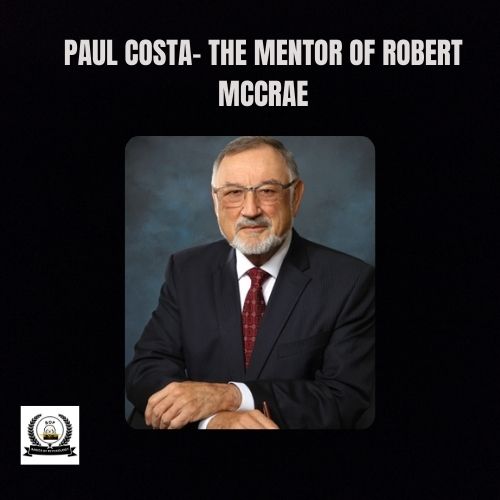
What Are Robert McCrae and Paul Costa Known For?
The Five-Factor Model: Their Monumental Achievement
Paul Costa and Robert McCrae are mainly recognized for their creation of the Five-Factor Model (FFM), which often is referred to as the Big Five personality traits or five factor theory. This model is a comprehensive framework for personality assessment, which includes Openness to Experience, Conscientiousness, Extraversion, Agreeableness, and Neuroticism (OCEAN).
Unveiling The Dimensions of Personality
Their research has provided an understanding to the intricacies of personality, and the mechanisms through which individual differences in behaviour, cognition and emotions come to play. The Big Five model has been the foundation of personality assessment, which has led to the creation of a standardized way of understanding personality traits.
Cross-Cultural Applicability
McCrae and Costa’s study has gone beyond the cultural divide as it portrays the universal nature of the Big Five dimensions. Through multiple cross-cultural studies, they proved that these dimensions remained the same in populations across the globe, thereby strengthening the basis of their model.
Impact and Influence
The groundbreaking work of Costa and Mccrae on the Big Five trait theory has had a great impact on different fields such as clinical psychology, organizational psychology, and personality assessment. The model has enabled the development of more accurate predictions of behavior, expanded individual differences evaluation, and increased the comprehension of personality patterns.
Robert Mccrae’s Theory
The Five Factor Theory, which is also referred to as the Big Five Theory, can be described as the backbone of modern personality psychology. Created in 1992 by Robert McCrae and Paul Costa, the Big Five Personality Theory states that the human personality can be described along five broad dimensions.
What Is The Big 5 theory?
The Big Five Theory posits that these five dimensions encompass the basic constituents of personality that remain fairly constant despite the varied conditions and periods. Contrary to the earlier personality theories that were based on classifying individuals into specific personality types, the Big Five Trait Theory stresses on the continuous nature of personality traits, considering them as existing along a spectrum.
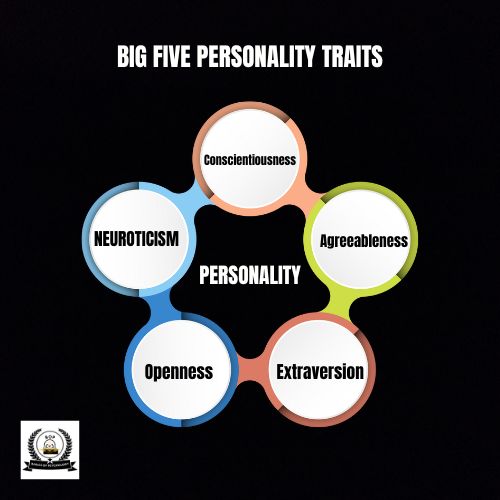
What Are The Big Five Personality Traits Costa and McCrae 1992?
In their pioneering work, Costa and McCrae discovered the following ‘Big Five personality traits’:
| Openness to Experience | Individuals high in ‘Openness to experience’ are imaginative, curious, and adventurous. The ones who are low in ‘openness’ prefer the familiar and the traditional. |
| Conscientiousness | People high in Conscientiousness are orderly, punctual, and disciplined. They have exceptional self-control, set high goals, and are actively engaged in their tasks and responsibilities. |
| Extraversion | People high in Extraversion are very lively, sociable, and assertive. They are social animals, easily make friends, and are so happy. |
| Agreeableness | People high in Agreeableness prioritize harmony, empathy, and cooperation. They are caring, trustworthy, thoughtful, and appreciate relationships, trying to keep peace and goodwill. |
| Neuroticism | The ‘personality’ trait of ‘Neuroticism’ consists of a greater chance of having anxiety, depression, and vulnerability. People with high ‘neuroticism’ have mood swings and emotional instability, while those with low ‘neuroticism’ are more resilient and emotionally stable. |
What Is Five-Factor Model Also Known As?
The ‘Five-Factor Model’ (FFM) is also called:
- ‘Big Five Personality Traits’
- OCEAN Model
- CANOE Model
- ‘Five-Factor Theory’
- Global Factors of Personality
How Were The Big Five Discovered?
The ‘Big Five’ discovery was based on a factor analysis intensive research which attempted to identify the underlying structure of personality traits. Factor analysis of personality questionnaires and assessments given to diverse samples showed that researchers observed consistent patterns of covariation among ‘traits’, which led to the identification of the ‘Big Five’ dimensions.
How Was The Big 5 Developed?
The construction of the Big Five has emerged through an ongoing process of empirical research and refinement. Costa and McCrae carried out longitudinal studies, cross-cultural comparisons, and psychometric analyses to refine the model and confirm its reliability and validity across different populations and contexts.
Is Big Five Scientific?
The scientific validity of the Big Five ‘Trait Theory’ has been rigorously checked in decades of personality psychology research. Countless investigations show the cross-cultural stability, predictive validity, and applicability of the ‘Big Five’ in domains such as individual differences, interpersonal relations, career success, and mental health issues.
While the ongoing debates and discussions continue within the field, the overwhelming evidence supports the scientific robustness of the Big Five ‘Personality Theory’ as a useful tool for understanding human personality.
Related Reading: Gordon Allport: Mastermind Behind Modern Psychology
Why Is The Big 5 Useful?
The ‘Big Five’ framework has applications in a variety of domains. Some of these are discussed below:
| Psychology and Research | The ‘Big Five model’, created by ‘Robert McCrae and Paul Costa’, offers a strong basis for the comprehension of “personality traits.” It simplifies the research into various psychological phenomena. |
| Clinical Psychology and Therapy | Clinically, ‘big five traits’ shed light on diagnosing and treating mental health conditions. The ‘personality’ profile knowledge by therapists enables them to tailor interventions to reflect their clients’ characteristics and tendencies. |
| Organizational Psychology and HR | Companies use the ‘Big Five’ to improve employee selection, performance evaluation, and team dynamics. ‘Personality’ tests help organizations identify the right candidates in terms of job fit, leadership skills and team composition. |
| Education and Academic Achievement | In education the ‘Five-Factor Theory’ is a basis of teaching strategies, student counseling, and academic interventions. Identifying student’s ‘personality traits’ makes teachers able to accommodate different learning styles, give the right help and create a good learning atmosphere. |
| Social Sciences and Relationships | The ‘Five-Factor Theory’ explains the interpersonal relationships and relationship satisfaction. Scientists study the influence of ‘personality traits’ on attraction, communication, and conflict resolution in relationships. |
Robert Mccrae’s Contributions to Psychology
Robert R. McCrae, a major figure in psychology, has made substantial contributions to the following main areas:
Personality Theory
Robert R. McCrae’s research focuses on the development of the Five Factor Model (FFM), which categorizes personality traits into five key dimensions: the openness, the conscientiousness, the extraversion, the agreeableness, and the neuroticism.
This model provides a comprehensive blueprint how ‘personality’ differs from one another across various contexts and populations.
Cross-Cultural Psychology
McCrae also conducted cross-cultural studies which focused on how one’s personality is expressed across different cultures. His research highlights the need to take into account cultural differences in personality assessment and human behavior, showing both universal patterns and cultural nuances in personality expression.
The Five Factor Model (FFM)
McCrae’s research on the FFM has made a high impact on psychology and related areas. The model is the basic instrument for ‘personality assessment’ and is used in decisions about hiring, therapy, and understanding the differences in behavior and cognition.
Through his works, we have grown in our knowledge about the human ‘personality’ and behavior, which has become a cornerstone to the discipline of psychology and its use in various environments.
Personality Measurement
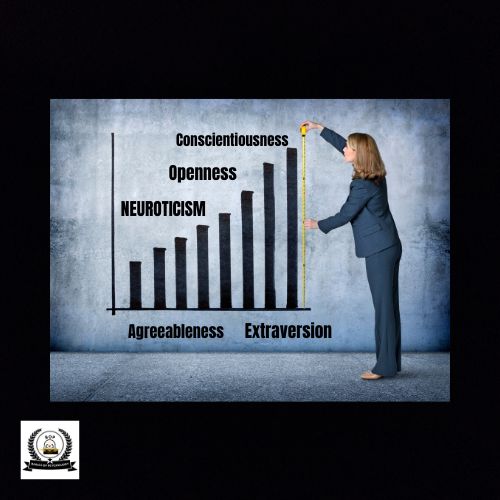
Psychometrics techniques that include an instrument designed to assess individuals’ levels of openness, conscientiousness, extraversion, agreeableness, and neuroticism are used in measuring the Big Five personality traits. This model is the heart of personality psychology, a complete system for understanding ‘personality structure’.
The NEO-PI-R (Revised NEO Personality Inventory), created by Costa and McCrae, is a widely used tool in this respect. It comprises of 240 items, which are classified into six sub-scales for ‘traits’, each of the ‘Big Five’ dimensions, producing an in-depth perception of personality.
A personality psychologist can use the NEO-PI-R to assess individuals, who rate the extent to which each item is applicable to them. The scores have the traits and facets for each trait that help a person know about his/her ‘personality’ strengths and weaknesses.
Additionally, measures such as the Big Five Inventory (BFI) and the International Personality Item Pool (IPIP) are also in widespread use and give personality professionals a lot of variety in assessing individual differences.
Related Reading: James McKeen Cattell: Authoritative Figure in Psychology
Robert Mccrae Books
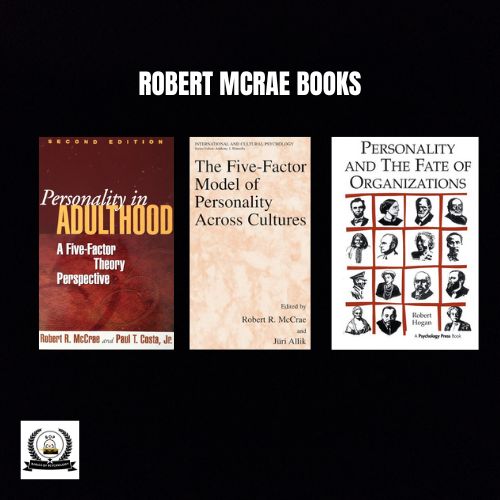
‘Robert McCrae’ has written or collaborated on a number of books. Here are some of them:
| “Personality in Adulthood: A ‘Five-Factor Theory’ Perspective” | Examines how people’s personality develops and change with growing age with a focus on the ‘Five-Factor Theory’. It delves into how ‘Big Five personality traits’ shape adult behavior, relationships, and well-being. |
| “The ‘Five-Factor Model’: Issues and Applications” (1992) | Examines the ‘Five-Factor Model’ of ‘Personality’ and its applications in psychology, corporate behavior, and clinical assessment. |
| “Personality Development Across the Lifespan” (2011) | Discusses how one’s personality is formed throughout the lifespan, considering the genetic, environmental, and experiential factors that affect its shape. |
| “Personality and the Fate of Organizations” (2012) | Explores how the ‘personality traits’ of individuals affect leadership, team dynamics, and organizational culture, and provides practical advice on how to optimize organizations. |
| “The ‘Five-Factor Model’ of Personality Across Cultures” (2002) | Reviews the cross-cultural use of the ‘Big Five’ personality dimensions, pointing out the differences in their expression and their meaning. |
Conclusion
Robert McCrae emerged as a personality who reached the heights of success. From his first steps to his substantial contribution to the field, McCrae’s path as a psychologist is both motivating and influential.
McCrae’s commitment to research and education, however, allowed him to be at the forefront of psychology during his career. His co-operation with Paul Costa led to the creation of the Five-Factor Model, which is a comprehensive framework for ‘personality assessment’. McCrae’s numerous awards and accolade clearly demonstrate his influence in the field which is far-reaching.
Although possibly being McCrae’s most significant discovery, his immortality comes from his long-lasting theories and influencing publications. His work still influences the landscape of psychology, giving us precious information about human behavior and ‘personality’ dynamics.
In summary, the article on the life and work of ‘Robert McCrae’ highlights the comprehensive effect that he has had on the field of psychology. The aspiring psychologists may get their inspiration from his commitment and breakthroughs, but researchers can benefit from his lasting theories and ideas.
Pro Tip From Basics of Psychology
The Big Five Theory can be used in ‘personality assessment’ for a more in-depth understanding of the individual differences. This has the effect of predicting behaviors and deciding factors like career success and social relationships. For example, ‘extraversion’ can be used as an indicator of social outcomes while ‘conscientiousness’ reveals organizational skills. Personalize the interventions according to the individual ‘personality’ profiles for more effective results.

